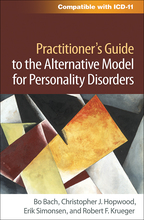Practitioner's Guide to the Alternative Model for Personality Disorders
Bo Bach, Christopher J. Hopwood, Erik Simonsen, and Robert F. Krueger
HardcoverPaperbacke-bookprint + e-book
Hardcover
orderFebruary 14, 2025
ISBN 9781462556496
Price: $72.00 302 Pages
Size: 6" x 9"
Paperback
orderJanuary 20, 2025
ISBN 9781462556489
Price: $48.00 302 Pages
Size: 6" x 9"
“This book could easily be called the Rosetta Stone of personality disorders. For clinicians treating clients with severe and persistent mental disorders, or those in training for such work, this guide is indispensable. It expertly synthesizes and clarifies existing diagnostic systems, unifying them into a single, practical model. Offering clinician-focused guidelines, the volume integrates the latest research and provides solutions to most diagnostic challenges in this complex field. Comprehensive, well organized, and filled with clinical vignettes, this book is an invaluable resource for both students and seasoned practitioners. A much-needed and highly recommended resource.”

—Peter Fonagy, CBE, FMedSci, FBA, FAcSS, Head, Division of Psychology and Language Sciences, University College London, United Kingdom
“This book masterfully demonstrates the AMPD's clinical utility and provides a roadmap for realizing the model's potential to refine mental health treatment practices. The volume does an excellent job of showing how a dimensional approach can help us understand the full continuum of personality functioning, so we can describe persons, not just disorders. Laced throughout with examples of using the AMPD to guide clinical decision making, this is a needed book for practitioners seeking to understand and help people with any type of emotional or behavioral problems. In a graduate course in psychopathology, the book would provide a compelling illustration of why the field is tending to move away from strict categorical diagnosis.”

—Leslie C. Morey, PhD, Department of Psychological and Brain Sciences (Emeritus), Texas A&M University
“In this ambitious volume, Bach and colleagues provide the first practical guide to using the AMPD in clinical practice. With helpful case examples and crosswalk tables, the book provides an accessible introduction to the model and offers a valuable primer for clinicians wondering about ways to integrate AMPD thinking into their care for patients.”

—Carla Sharp, PhD, John and Rebecca Moores Professor of Clinical Psychology and Associate Dean for Faculty and Research, University of Houston
“A uniquely comprehensive, clinically oriented, and practical guide to assessment and treatment using the AMPD. The book is chock-full of vivid case examples and replete with tables and diagrams summarizing key points. For students and early-career mental health clinicians, this book provides a solid foundation for learning about diagnosis and treatment of personality pathology in the classroom or on the job. For more experienced clinicians, the book eases the transition from traditional categorical personality disorder assessment models to the new, more clinically useful dimensional models embedded in DSM-5-TR and ICD-11. Readers from any theoretical or treatment orientation will find this guide an invaluable asset in the care of patients with personality pathology.”

—Andrew E. Skodol, MD, Research Professor of Psychiatry, University of Arizona College of Medicine
—Peter Fonagy, CBE, FMedSci, FBA, FAcSS, Head, Division of Psychology and Language Sciences, University College London, United Kingdom
“This book masterfully demonstrates the AMPD's clinical utility and provides a roadmap for realizing the model's potential to refine mental health treatment practices. The volume does an excellent job of showing how a dimensional approach can help us understand the full continuum of personality functioning, so we can describe persons, not just disorders. Laced throughout with examples of using the AMPD to guide clinical decision making, this is a needed book for practitioners seeking to understand and help people with any type of emotional or behavioral problems. In a graduate course in psychopathology, the book would provide a compelling illustration of why the field is tending to move away from strict categorical diagnosis.”
—Leslie C. Morey, PhD, Department of Psychological and Brain Sciences (Emeritus), Texas A&M University
“In this ambitious volume, Bach and colleagues provide the first practical guide to using the AMPD in clinical practice. With helpful case examples and crosswalk tables, the book provides an accessible introduction to the model and offers a valuable primer for clinicians wondering about ways to integrate AMPD thinking into their care for patients.”
—Carla Sharp, PhD, John and Rebecca Moores Professor of Clinical Psychology and Associate Dean for Faculty and Research, University of Houston
“A uniquely comprehensive, clinically oriented, and practical guide to assessment and treatment using the AMPD. The book is chock-full of vivid case examples and replete with tables and diagrams summarizing key points. For students and early-career mental health clinicians, this book provides a solid foundation for learning about diagnosis and treatment of personality pathology in the classroom or on the job. For more experienced clinicians, the book eases the transition from traditional categorical personality disorder assessment models to the new, more clinically useful dimensional models embedded in DSM-5-TR and ICD-11. Readers from any theoretical or treatment orientation will find this guide an invaluable asset in the care of patients with personality pathology.”
—Andrew E. Skodol, MD, Research Professor of Psychiatry, University of Arizona College of Medicine



